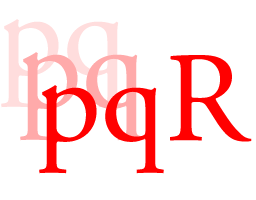Let’s load the needed packages:
Improving Binning by Bootstrap Bumping
In the post (https://statcompute.wordpress.com/2018/11/23/more-robust-monotonic-binning-based-on-isotonic-regression), a more robust version of monotonic binning based on the isotonic regression was introduced. Nonetheless, due to the loss of granularity, the predictability has been somewhat compromised, which is a typical dilemma in the data science. On one hand, we don’t want to use a learning algorithm that is too greedy and therefore over-fits the data at the cost of simplicity and generality. On the other hand, we’d also like to get the most predictive power out of our data for better business results.
New version of pqR, with major speed improvements
|

If you did not already know
DeepFuse  We present a novel deep learning architecture for fusing static multi-exposure images. Current multi-exposure fusion (MEF) approaches use hand-crafted features to fuse input sequence. However, the weak hand-crafted representations are not robust to varying input conditions. Moreover, they perform poorly for extreme exposure image pairs. Thus, it is highly desirable to have a method that is robust to varying input conditions and capable of handling extreme exposure without artifacts. Deep representations have known to be robust to input conditions and have shown phenomenal performance in a supervised setting. However, the stumbling block in using deep learning for MEF was the lack of sufficient training data and an oracle to provide the ground-truth for supervision. To address the above issues, we have gathered a large dataset of multi-exposure image stacks for training and to circumvent the need for ground truth images, we propose an unsupervised deep learning framework for MEF utilizing a no-reference quality metric as loss function. The proposed approach uses a novel CNN architecture trained to learn the fusion operation without reference ground truth image. The model fuses a set of common low level features extracted from each image to generate artifact-free perceptually pleasing results. We perform extensive quantitative and qualitative evaluation and show that the proposed technique outperforms existing state-of-the-art approaches for a variety of natural images. …
We present a novel deep learning architecture for fusing static multi-exposure images. Current multi-exposure fusion (MEF) approaches use hand-crafted features to fuse input sequence. However, the weak hand-crafted representations are not robust to varying input conditions. Moreover, they perform poorly for extreme exposure image pairs. Thus, it is highly desirable to have a method that is robust to varying input conditions and capable of handling extreme exposure without artifacts. Deep representations have known to be robust to input conditions and have shown phenomenal performance in a supervised setting. However, the stumbling block in using deep learning for MEF was the lack of sufficient training data and an oracle to provide the ground-truth for supervision. To address the above issues, we have gathered a large dataset of multi-exposure image stacks for training and to circumvent the need for ground truth images, we propose an unsupervised deep learning framework for MEF utilizing a no-reference quality metric as loss function. The proposed approach uses a novel CNN architecture trained to learn the fusion operation without reference ground truth image. The model fuses a set of common low level features extracted from each image to generate artifact-free perceptually pleasing results. We perform extensive quantitative and qualitative evaluation and show that the proposed technique outperforms existing state-of-the-art approaches for a variety of natural images. …
Whats new on arXiv
MALTS: Matching After Learning to Stretch
Whats new on arXiv
Graph Convolutional Neural Networks via Motif-based Attention
RQuantLib 0.4.6: Updated upstream, and calls for help
The new 0.4.6 release of RQuantLib arrived on CRAN and Debian earlier today. It is two-fold update: catching up QuantLib 1.14 while also updating to Boost 1.67 (and newer).
Statistics Sunday: Introduction to Regular Expressions
In my last Statistics Sunday post, I briefly mentioned the concept of regular expressions, also known as regex (though note that in some contexts, these refer to different things – see here). A regular expression is a text string, which you ask your program to match. You can use this to look for files with a particular name or extension, or search a corpus of text for a specific word or word(s) that match a certain pattern. This concept is used in many programming languages, and R is no exception. In order to use a regular expression, you need a regular expression engine. Fortunately, R base and many R packages come with a regular expression engine, which you call up with a function. In R base, those functions are things like grep, grepl, regexpr, and so on.
These 3 problems destroy many clinical trials (in context of some papers on problems with non-inferiority trials, or problems with clinical trials in general)
Paul Alper points to this news article in Health News Review, which says:
Document worth reading: “Customised Structural Elicitation”
Established methods for structural elicitation typically rely on code modelling standard graphical models classes, most often Bayesian networks. However, more appropriate models may arise from asking the expert questions in common language about what might relate to what and exploring the logical implications of the statements. Only after identifying the best matching structure should this be embellished into a fully quantified probability model. Examples of the efficacy and potential of this more flexible approach are shown below for four classes of graphical models: Bayesian networks, Chain Event Graphs, Multi-regression Dynamic Models, and Flow Graphs. We argue that to be fully effective any structural elicitation phase must first be customised to an application and if necessary new types of structure with their own bespoke semantics elicited. Customised Structural Elicitation